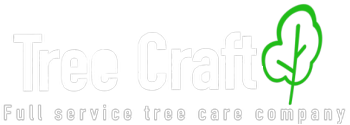Emerald Ash Borers (EAB) pose a significant threat to ash trees across North America, causing widespread damage and even death to these beloved trees. Detecting EAB infestations early is crucial for effective management and preservation of ash tree populations. Understanding the signs and symptoms of EAB infestation empowers tree service professionals and homeowners to take timely action. Considering this, we at Tree Craft Tree Service would like to take the opportunity to share some of the key indicators of EAB presence and offer insights on detection methods.
Signs of an Emerald Ash Borer Infestation
Thinning Tree Canopy – One of the primary signs of EAB infestation is canopy thinning or dieback. Infested ash trees typically exhibit thinning foliage, especially in the upper branches. As the infestation progresses, the canopy may become increasingly sparse, with branches devoid of leaves. This decline in canopy health is often an indication of EAB larvae feeding within the tree, disrupting its nutrient transport system.
D-shaped Exit Holes – Emerald Ash Borers leave distinct exit holes in the bark of infested trees. These exit holes are D-shaped and about 1/8 inch in diameter, serving as telltale signs of EAB activity. Observing these small, uniquely shaped holes on the trunk and branches of ash trees can help confirm infestation. However, they may not be visible in the early stages of infestation or on smaller trees.
Serpentine Galleries – Underneath the bark of an infested ash tree, EAB larvae create serpentine galleries as they feed on the tree’s inner bark. These galleries appear as winding, S-shaped patterns and are distinctive markers of EAB infestation. To inspect for galleries, carefully peel back a section of the bark, paying close attention to the wood beneath. Presence of serpentine galleries confirms active EAB infestation and ongoing damage to the tree’s vascular system.
Foliage Irregularities – Aside from canopy thinning, infested ash trees may display other foliage irregularities. This includes premature yellowing, wilting, or browning of leaves, often starting at the top of the tree and progressing downward. Unusual leaf growth patterns, such as shoots sprouting from the trunk or lower branches, can also indicate stress caused by EAB infestation.
Woodpecker Activity – Increased woodpecker activity on ash trees can be a sign of EAB presence. Woodpeckers are natural predators of EAB larvae and may target infested trees in search of food. Patches of missing bark or extensive woodpecker damage, particularly concentrated around the upper trunk and branches, suggest an underlying EAB infestation.
Emergency Tree Removal in West Norriton Township, Tredyffrin Township, East Norriton, Radnor, Wayne, Saint Davids, Lower Merion Township, Norristown, Upper Merion Township, Phoenixville & Greater King of Prussia, Pennsylvania
Early detection of Emerald Ash Borers is critical for mitigating their impact on ash tree populations. By recognizing the signs and symptoms of infestation, tree service professionals and homeowners can implement appropriate management strategies to protect valuable ash trees. Regular monitoring, prompt reporting of suspected infestations, and collaboration with local authorities are essential for effective EAB control efforts and the preservation of ash tree ecosystems. Stay vigilant and proactive in safeguarding ash trees against this invasive pest. If you suspect Emerald Ash Borers have taken over your trees, call in the experts of Tree Craft Tree Service for help.




